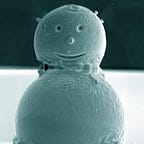More thoughts on the enigma of top-down (downward) causation (2)
After publishing “More thoughts on the enigma of top-down (downward) causation” I’ve been continuing to read and think about these things.
Downward causation (the idea that the whole of a system can influence its parts in ways that cannot be reduced to the local interactions between the parts) is not really mysterious.
There are good papers and books with thoughtful and subtle points about downward causation. But I stick to the simplest point:
The currently understood laws of fundamental physics are not causally closed, but open to different possible outcomes. This leaves room for other fundamental natural laws to operate independently. This is downward causation in a nutshell. See also my book [*].
In the words of George Ellis (source: “How Can Physics Underlie the Mind? Top-Down Causation in the Human Context”):
“Because of the existence of random processes at the bottom, there is sufficient causal slack to allow this kind of top-down effect to occur without violation of physical causation. In general, the outcome is not uniquely determined from initial data because of lower level random processes. Physical processes do not determine a unique outcome… Quantum uncertainty applies at the bottom.
Because of the existence of quantum processes at the bottom, physics is not deterministic, despite the way many writers represent the situation as if it is. It seems that the profound nature of the quantum revolution has still not permeated the consciousness of many physicists and biologists, who present the situation as if physics were deterministic all the way down. This is not the case: the bottom level is not deterministic. At its base level, the universe is indeterministic, allowing the needed causal slack freeing higher levels from lower level causal determinism.”
So other fundamental natural laws can apply to thermodynamics, chemistry, biology, mind, … , and other aspects of the world, perhaps all the way up to Deity.
Don’t try to imagine “how” these other laws work: They just do. Why should reality conform to what our small minds can imagine at this moment? Ruth Kastner often quotes Ernan McMullin’s observation:
“But imaginability must not be made the test for ontology. The realist claim is that the scientist is discovering the structures of the world; it is not required in addition that these structures be imaginable in the categories of the macroworld.”
If you want some kind of intuitive “visual” model, see my book [*] (Chapter 18). The idea is that different Everett worlds unfold for a short while (perhaps very short from our perspective), but then most of those worlds evaporate into nothingness, or something like that, while the “fittest” winners take all and become fully real according to certain reality selection criteria, which implement downward causation.
In view of computational irreducibility, this model makes a lot of sense as a reality generation strategy in the context of the simulation hypothesis [*].
What if no world survives? Or in other words, what if reality is over-determined by the applicable laws? There could be a hierarchy of levels (e.g. chemistry before biology), but perhaps the simplest answer is that, at any given moment, the known natural laws only scratch the thin surface of a thick reality that can’t be reduced to a finite description. In the words of William James (source: “A Pluralistic Universe”):
“Thought deals thus solely with surfaces. It can name the thickness of reality, but it cannot fathom it, and its insufficiency here is essential and permanent, not temporary.”
[*] My book “Tales of the Turing Church: Hacking religion, enlightening science, awakening technology” is available for readers to buy on Amazon (Kindle | paperback).
Please buy my book, and/or donate to support other Turing Church projects.
Cover picture from Wikimedia Commons.
